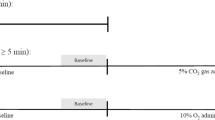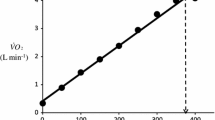Abstract
The aim of this study was to characterize the time course of maximal oxygen consumption \(({\dot{V}}\hbox{O}_{2\max})\) changes during bedrests longer than 30 days, on the hypothesis that the decrease in \({\dot{V}}\hbox{O}_{2\max}\) tends to asymptote. On a total of 26 subjects who participated in one of three bedrest campaigns without countermeasures, lasting 14, 42 and 90 days, respectively, \({\dot{V}}\hbox{O}_{2\max}\) maximal cardiac output \((\dot{Q}_{\rm max})\) and maximal systemic O2 delivery \(({\dot{Q}}\hbox{aO}_{2{\rm max}})\) were measured. After all periods of HDT, \({\dot{V}}\hbox{O}_{2\max},\;{\dot{Q}}_{\rm max}\) and \({\dot{Q}}\hbox{aO}_{2{\rm max}}\) were significantly lower than before. The \({\dot{V}}\hbox{O}_{2\max}\) decreased less than \({\dot{Q}}_{\rm max}\) after the two shortest bedrests, but its per cent decay was about 10% larger than that of \({\dot{Q}}_{\rm max}\) after 90-day bedrest. The \({\dot{V}}\hbox{O}_{2\max}\) decrease after 90-day bedrest was larger than after 42- and 14-day bedrests, where it was similar. The \({\dot{Q}}_{\rm max}\) and \({\dot{Q}}\hbox{aO}_{2{\rm max}}\) declines after 90-day bedrest was equal to those after 14- and 42-day bedrest. The average daily rates of the \({\dot{V}}\hbox{O}_{2\max}, \;{\dot{Q}}_{\rm max}\) and \({\dot{Q}}\hbox{aO}_{2{\rm max}}\) decay during bedrest were less if the bedrest duration were longer, with the exception of that of \({\dot{V}}\hbox{O}_{2\max}\) in the longest bedrest. The asymptotic \({\dot{V}}\hbox{O}_{2\max}\) decay demonstrates the possibility that humans could keep working effectively even after an extremely long time in microgravity. Two components in the \({\dot{V}}\hbox{O}_{2\max}\) decrease were identified, which we postulate were related to cardiovascular deconditioning and to impairment of peripheral gas exchanges due to a possible muscle function deterioration.



Similar content being viewed by others
References
Antonutto G, Girardis M, Tuniz D, di Prampero PE (1995) Noninvasive assessment of cardiac output from arterial pressure profiles during exercise. Eur J Appl Physiol 71:18–24
Barker RC, Hopkins SR, Kellogg N, Olfert IM, Brutsaert TD, Gavin TP, Entin PL, Rice AJ, Wagner PD (1999) Measurement of cardiac output during exercise by open-circuit acetylene uptake. J Appl Physiol 87:1506–1512
Belin de Chantemèle E, Blanc S, Pellet N, Duvareille M, Ferretti G, Gauquelin-Koch G, Gharib C, Custaud MA (2004) Does resistance exercise prevent body fluid changes after a 90-day bed rest? Eur J Appl Physiol 92:555–564
Biolo G, Ciocchi B, Lebenstedt M, Barazzoni R, Zanetti M, Platen P, Heer M, Guarneri G (2004) Short-term bed rest impairs amino acid-induced protein anabolism in humans. J Physiol 558:381–388
Capelli C, Cautero M, di Prampero PE (2001) New perspectives in breath-to-breath determination of alveolar gas exchange in humans. Pflügers Arch. 441:566–577
Carson ER, Cobelli C, Finkelstein L (1983) The mathematical modelling of metabolic and endocrine systems. Wiley, New York, pp 179–216
Connett RJ, Gayeski TEJ, Honig CR (1986). Lactate efflux is unrelated to intracellular PO2 in working red skeletal muscle in situ. J Appl Physiol 61:402–408
Convertino VA (1996) Exercise and adaptation to microgravity environments. In: Fregley MJ, Blatteis CM (eds) Handbook of physiology, section 4, environmental physiology, Oxford Univerisy Press, New York, pp 815–843
Convertino VA (1997) Cardiovascular consequences of bed rest: effect on maximal oxygen uptake. Med Sci Sports Exerc 29:191–196
Convertino VA, Hung J, Goldwater DJ, Debusk RF (1982) Cardiovascular responses to exercise in middle age men after 10 days of bed-rest. Circulation 65:134–140
di Prampero PE (1985) Metabolic and circulatory limitations to VO2max at the whole animal level. J Exp Biol 115:319–331
di Prampero PE, Ferretti G (1990) Factors limiting maximal oxygen consumption in humans. Respir Physiol 80:113–128
Ferretti G (1997) The effect of prolonged bed rest on maximal instantaneous muscle power and its determinants. Int J Sports Med 18:S287–S289
Ferretti G, Antonutto G, Denis C, Hoppeler H, Minetti AE, Narici MV, Desplanches D (1997) The interplay of central and peripheral factors in limiting maximal O2 consumption in man after prolonged bed rest. J Physiol 501:677–690
Friman G (1979) Effect of clinical bed rest for seven days on physical performance. Acta Med Scand 205:389–393
Georgievskiy VS, Kakurin LI, Katkovskii BS, Senkevich YA (1966) Maximum oxygen consumption and functional state of the circulation in simulated zero gravity. In: Lauer NV, Kilchinskaya AZ (eds) The oxygen regime of organism and its regulation. Naukova Dumka, Kiev, pp 181–184
Greenleaf JE, Bernauer EM, Ertl AC, Trowbridge TS, Wade CE (1989) Work capacity during 30 days of bed rest with isotonic and isokinetic exercise training. J Appl Physiol 67:1820–1826
Grønlund L (1984) A new method for breath-to-breath determination of oxygen flux across the alveolar membrane. Eur J Appl Physiol 52:167–172
Kakurin LI, Akhrem-Adremovich RM, Vanyushina YV, Varbaronov RA, Georgiyevskii VS, Kotkovskiy BS, Kotkovskaya AR, Mukhaerlyamov NM, Panferova NY, Pushkar YT, Senkevich YA, Simpura SF, Cherpakhin MA, Shamrov PG (1966) The influence of restricted muscular activity on man’s endurance of physical stress, accelerations and orthostatics. In: Soviet conference on space biology and medicine, Moscow, pp 110–117
Kashihara H, Haruna Y, Suzuki Y, Kawakubo K, Takenaka K, Bonde-Petersen F, Gunji A (1994) Effects of mild supine exercise during 20 days bed rest on maximal oxygen uptake rate in young humans. Acta Physiol Scand Suppl 616:19–26
Meyer M, Scheid P (1980) Solubility of acetylene in human blood determined by mass spectrometry. J Appl Physiol 48:1035–1037
Richardson RS, Leigh JS, Wagner PD, Noyszewski EA (1999) Cellular PO2 as a determinant of maximal mitochondrial O2 consumption in trained human skeletal muscle. J Appl Physiol 87:325–331
Richardson RS, Newcomer SC, Noyszewski EA (2001) Skeletal muscle intracellular PO2 assessed by myoglobin desaturation: response to graded exercise. J Appl Physiol 91:2679–2685
Saltin B, Blomqvist CG, Mitchell RC, Johnson RL, Wildenthal K, Chapman CB (1968) Response to exercise after bed rest and after training. Circulation 38(Suppl. 7):1–78
Smorawinski J, Nazar K, Kaciuba-Uscilko H, Kaminska E, Cybulski G, Kodrzycka A, Bicz B, Greenleaf JE (2001) Effects of 3-day bed rest on physiological responses to graded exercise in athletes and sedentary men. J Appl Physiol 91:249–257
Stremel RW, Convertino VA, Bernauer EM, Greenleaf JE (1976) Cardiorespiratory deconditioning with static and dynamic leg exercise during bed rest. J Appl Physiol 41:905–909
Taylor HL, Henschel A, Brozek J, Keys A (1949) Effects of bed rest on cardiovascular function and work performance. J Appl Physiol 2:223–239
Trappe S, Trappe T, Gallagher P, Harber M, Alkner B, Tesch P (2004) Human single muscle fibre function with 84 day bed rest and resistance training. J Physiol 557:501–513
Trappe T, Trappe S, Lee G, Widrick J, Fitts R, Costill D (2006) Cardiorespiratory responses to physical work during and following 17 days of bed rest and spaceflight. J Appl Physiol 100:951–957
White PD, Nyberg JW, White WJ (1966) A comparative study of the physiological effects of immersion and recumbency. In: Proceedings of the 2nd annual biomedical research conference, Houston, TX, pp 117–166
Acknowledgments
This research was supported by the Italian Space Agency grant ASII/R/300/02 to Carlo Capelli and by the Swiss National Science Foundation Grants 31-64267.00 and 3200B0-102181 to G. Ferretti. The long-term bedrest study 2001–2002 was organized by the European Space Agency, together with the Centre National d’Etudes Spatiales and the Japanese National Space Development Agency. The Short Term Bed Rest-Integrative Physiology campaign 2001–2003 was organized by the European Space Agency, together with the German Space Agency (DLR). Many thanks to all of the very dedicated staff at the MEDES Institute for Space Medicine and Physiology in Toulouse, France and at the Institute of Aerospace Medicine of DLR, Germany. In particular, we greatly acknowledge the co-operation of Dr. Marie-Pierre Bareille, Dr. Alain Maillet, Dr. Jacques Bernard, Dr. Martina Heer and Dr. Andrea Boose. The authors are very grateful to the volunteers for their excellent dedication to the study. We heartily thank Dr. Pietro Enrico di Prampero for having discussed with us the ideas and concepts that contributed to the success of the paper.
Author information
Authors and Affiliations
Corresponding author
Rights and permissions
About this article
Cite this article
Capelli, C., Antonutto, G., Kenfack, M.A. et al. Factors determining the time course of \({\dot{V}}\hbox{O}_{2\max}\) decay during bedrest: implications for \({\dot{V}}\hbox{O}_{2\max}\) limitation. Eur J Appl Physiol 98, 152–160 (2006). https://doi.org/10.1007/s00421-006-0252-3
Accepted:
Published:
Issue Date:
DOI: https://doi.org/10.1007/s00421-006-0252-3




